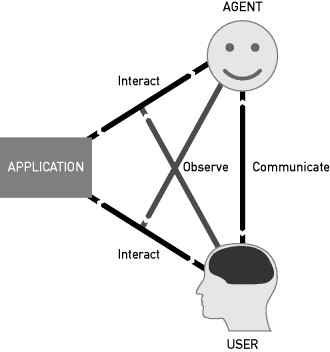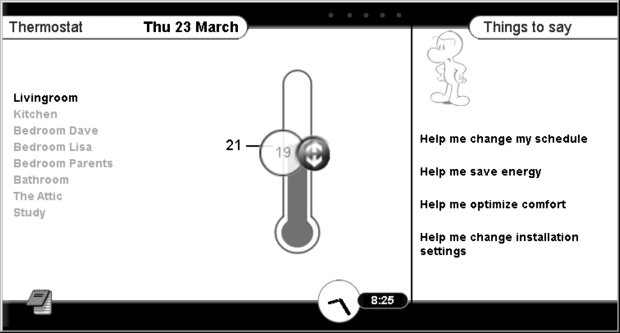4.3 Stimulating Energy Behavior Change in Current Design Practice
In the design discipline, there is growing interest to stimulate sustainable behavior through product and service design (e.g., Ehrenfeld, 2008; Kuijer and De Jong, 2009; Manzini, 2008). The design discipline operates at the intersection between technology and human behavior. The challenge for designers is thus to come up with products and services that enable sustainable lifestyles. A quick glance at design handbooks reveals that traditional design approaches consider individual users. This is also reflected in design strategies aimed at facilitating sustainable behavior in both product and interaction design.
4.3.1 Design Strategies to Stimulate Behavior
Strategies can be applied on a wide range of products, from making use of physical affordances (e.g., not allowing people to sleep on a public bench) to creating awareness (Lilley, 2009; Lockton, Harrison, and Stanton, 2010; Wever, Van Kuijk, and Boks, 2008). While these strategies provide handles on how to stimulate or constrain certain behaviors through product design, the design is always aimed at the behavior of individual users rather than groups of users.
4.3.2 Interaction Design
Many of the usability issues of common home energy management systems were recently highlighted by van Dam et al. (2012). One of the most important issues for the design of such a system is whether the user feels in control over the product, or feels the product is in control. The issue of control should be seen along a continuum from a product taking no action, giving suggestions and collaborating on tasks, to, at the far end, taking action completely autonomously. A great deal of criticism has been expressed toward smart products, such as cars equipped with adaptive cruise control that take action without due regard to the user context and needs, for example speeding up when the car is exiting the freeway simply because no car in front is detected (Norman, 2007). Ideally, a smart system should build a sense of trust over time, such that the user will begin to delegate mundane or repetitive tasks to the product. This implies that the system has some notion of the user's current energy consumption–related activities and a model of costs versus benefits in taking a particular form of action.
An important usability issue is the degree of transparency afforded by a home energy controller, that is, to what degree can the user understand, follow, and possibly change decisions or suggestions made by the system? Too much insight may become confusing, creating information overload, whereas too little may create a black box syndrome, whereby the user is less likely to trust and engage with the product. In the case of products with rich embedded functionality, a collaborative and narrative approach may be useful. In terms of tangible products, communicating what the product can or cannot do can be conveyed through the product's physicality. Work by Djajadiningrat and colleagues (2004) has focused on the role of design in creating a balance between a product's physical appearance and action potential, as communicated by perceived affordances. In short, at the cognitive level the user should be able to understand what the smart product does and how it can be of help in performing a certain task or fulfilling a certain goal.
In considering how user–product communication is currently supported, one is confronted with the problem of many of today's products: They interact with the user at a low hardware–software function level. Product interaction should support interaction with the product at a higher goal level. Many home control systems provide the user with a button or controller for every hardware function. One should consider user product interaction in terms of the need to support a range or hierarchy of control acts from communicating rudimentary settings to performing acts related to higher goals (Rasmussen, 1986).
4.3.3 Collaborating on Energy Management
Principles of collaboration can be used to enable the user to discuss with a home energy controller options for saving energy while maintaining or improving comfort. Depending upon the relative knowledge of the user and system, the product agent may transition back and forth between a tutoring or more assistive role. In a more assertive role, the product agent may even attempt to persuade the user to follow a certain goal that otherwise may have been neglected. Smart products, such as an Ibo robot, are commonly perceived as complex due to the amount of hidden functionality and their range of functions (Rijsdijk, 2006). However, studies conducted by Rich, Sidner, and Lesh (2001) demonstrated that the perceived complexity of a product may be reduced by designing a more goal-based collaborative system rather than one based on controlling low-level functions. Goals can be communicated between the user and product such that the product can help the user meet a goal (Figure 4.3.1). The advantage of a fully integrated collaborative interface is that the user is still encouraged to explore and learn about the system, rather than become dependent upon a help or wizard agent. For example, the intelligent thermostat concept (Keyson et al., 2001) shown in Figure 4.3.2 is based on models of collaboration stemming from the Collagen agent architecture (Rich, Sidner, and Lesh, 2001). The user can communicate task-level information via the right side of the screen by speaking in or selecting displayed sentences. The “Things to say” list is updated based on user actions in relation to a hierarchical task model. For example, if the user says “Go back”, then the system goes back to the previous task, rather than undoing the last button pressed at the function level. The user can request help with a higher level goal, such as “Help me save energy,” and can also communicate with the product at the function–feature level (e.g., change room temperature) by selecting items via the touch screen or speaking in terms. Knowing what the user can say to a product is critical. For example, DeKoven (2004) observed that without a “Things to say” window, one user asked the intelligent thermostat who the prime minister of Canada was during a trial session. Usability studies conducted by Freudenthal (2002) found that elderly people in particular appreciated being able to converse at a conversational level with the interface, rather than having to recall menu names and functions.
Figure 4.3.1 The collaborative paradigm (Rich, Sidner, and Lesh, 2001)

Figure 4.3.2 The intelligent thermostat prototype

